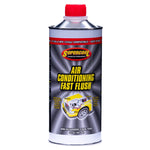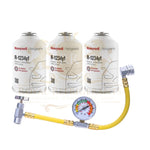You have no items in your shopping cart.
Everything You Need to Know About Automotive AC Refrigerant for HVAC and Automotive Applications
When you turn on your car’s air conditioner and feel that refreshing cool breeze, the credit goes to one crucial component — the automotive AC refrigerant. It’s the hidden hero behind every comfortable drive, especially during scorching summers.
Whether in vehicles or HVAC systems, refrigerants are essential for transferring heat and enabling effective cooling. In this guide, we’ll cover everything you need to know about automotive AC refrigerants, how they work, the types in use, environmental impacts, and future innovations in the world of cooling technology.
What Is Automotive AC Refrigerant?
An automotive AC refrigerant is a chemical compound that circulates within a vehicle’s air conditioning system. Its job is to absorb heat from inside the car cabin and release it outside, creating cool air for passengers.
This refrigerant constantly cycles through compression, condensation, expansion, and evaporation within a closed-loop system — making your car’s air conditioning both efficient and reliable.

How Automotive AC Refrigerant Works
The operation of an automotive air conditioning system is based on thermodynamics — the movement of heat from one place to another.
Here’s how it works step-by-step:
Compression:
The AC compressor pressurizes the refrigerant gas, increasing its temperature.
Condensation:
The hot, high-pressure gas passes through the condenser, cooling down and becoming a liquid.
Expansion:
The liquid refrigerant moves through an expansion valve, where it rapidly cools and drops in pressure.
Evaporation:
The cold refrigerant absorbs heat from inside the car through the evaporator coil, turning back into a gas.
This continuous cycle keeps your cabin temperature comfortable even under extreme conditions.
Common Types of Automotive AC Refrigerants
Over time, refrigerant technology has evolved to improve performance and reduce environmental harm. Below are the most common types used in automotive systems:
| Refrigerant Type | Used In | Environmental Impact | Notes |
|---|---|---|---|
| R-12 (Freon-12) | Cars before 1995 | High Ozone Depletion Potential | Banned globally due to ozone harm |
| R-134a | Cars from 1995–2016 | Moderate Global Warming Potential | Most widely used for years |
| R-1234yf | 2017–present vehicles | Very Low GWP, eco-friendly | Standard in modern cars |
| R-744 (CO₂) | Luxury and electric vehicles | Natural refrigerant | Highly efficient and sustainable |
💡 Pro Tip: Always use the correct refrigerant specified by your car’s manufacturer. Mixing types can damage the system and affect cooling performance.
Automotive AC Refrigerant vs. HVAC Refrigerant
Although both systems serve the same purpose — cooling — their designs and refrigerants differ due to operational needs.
| Aspect | Automotive AC Systems | HVAC Systems |
|---|---|---|
| Common Refrigerants | R-134a, R-1234yf, R-744 | R-22, R-410A, R-32 |
| System Design | Compact, mobile, high-pressure | Stationary, large, consistent flow |
| Cooling Speed | Rapid, short bursts | Continuous, large-area cooling |
| Maintenance | Frequent servicing due to mobility | Periodic maintenance |
Both use the same scientific principles of heat exchange, but automotive systems are designed to handle higher pressures, vibrations, and temperature variations.
Signs Your Car’s AC May Need Refrigerant Service
If your car’s AC isn’t cooling as effectively as before, it could be due to low refrigerant levels or a leak. Look out for these signs:
-
Warm or weak airflow
-
Hissing or bubbling noises from the AC system
-
Compressor clutch not engaging
-
Oily residue near AC hoses or fittings
-
Foul or musty odor from vents
⚠️ Important: Running your AC with low refrigerant can damage the compressor — one of the costliest components to replace.
Environmental and Regulatory Considerations
Older refrigerants like R-12 and R-22 were phased out because of their ozone-depleting properties. International protocols like the Montreal Protocol and updated EPA regulations now enforce the use of environmentally safer alternatives such as R-1234yf and R-744 (CO₂).
These new-generation refrigerants provide:
-
Lower Global Warming Potential (GWP)
-
Higher efficiency
-
Reduced environmental impact
Eco-Friendly Alternatives and the Future of Refrigerants
As environmental awareness grows, both the automotive and HVAC industries are adopting eco-friendly refrigerants. Future trends include:
-
R-1234yf – Widely used in new vehicles; low GWP and non-ozone depleting.
-
R-744 (CO₂) – A natural refrigerant gaining popularity in high-end and electric vehicles.
-
R-32 & R-454B – Efficient refrigerants now standard in modern HVAC systems.
These innovations are setting the stage for sustainable cooling solutions worldwide.
Maintenance Tips for Automotive AC Systems
To ensure your car’s air conditioning system stays in top condition:
-
Check AC performance regularly, especially before summer.
-
Don’t overcharge — excessive refrigerant can damage seals and the compressor.
-
Inspect for leaks — even small leaks can lead to costly repairs.
-
Have your system serviced by professionals who use the correct tools and refrigerants.
-
Replace cabin air filters periodically to maintain airflow and efficiency.
Conclusion
The automotive AC refrigerant is at the heart of every cooling system, providing comfort and performance on the road. By understanding how it works, the types available, and their environmental implications, you can make informed decisions for maintenance and upgrades.
As the industry moves toward more eco-friendly refrigerants, the future of automotive and HVAC cooling systems looks cleaner, safer, and more energy-efficient than ever.
 English
English







